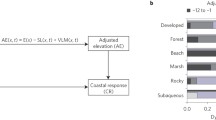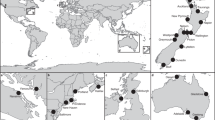Abstract
The last two assessments of the Intergovernmental Panel on Climate Change (IPCC) predict that rates of sea level rise will begin to accelerate by c. 2030–2040 CE. Considering that many marsh systems are already under threat from existing sea level trends, a dramatic upswing in rate only a few decades away poses critical questions about what the future may hold for these marshes (and those yet to manifest sea level impacts) requires coast-wide assessments. Extrapolations of detailed historical trends traditionally have provided the least equivocal way of providing such information, but the necessary data required for this approach are often lacking. In this paper, we describe how logistic regression analysis applied to spatial data on marsh loss and degradation—in this case derived from a validated Landsat-based marsh condition model—and its relation to such readily determined parameters as distance from shorelines or tidal creeks can be used to predict where future marsh losses may occur, even in those systems not presently affected. As such, it affords more targeted information for planning than can be had from general submergence versus accretion/elevation change models (e.g., SLAMM) that are limited by the paucity of vertical accretion data. The results also reinforce the concept that marsh adjustment to sea level rise can be broadly deduced at the landscape level, which in some respects is independent of marsh type and is responsive to tidal frame and coastal profile.











Similar content being viewed by others
References
Alber EM, Swenson S, Adamowicz C, Mendelssohn IA (2008) Salt marsh dieback: an overview of recent events in the US. Estuar Coastal Shelf Sci 80:1–11
Anselin L (1988) Spatial econometrics: methods and models. Kluwer, Dordrecht
Beardsley RC, Boicourt WC (1981) On estuarine and continental shelf circulation in the Middle Atlantic Bight. In: Warren BA, Wunsch C (eds) Evolution of physical oceanography. MIT, Cambridge, pp 198–233
Bindoff NL, Willebrand J, Artale V, Cazenave A, Gregory J, Gulev S, Hanawa K, Le Quéré C, Levitus S, Nojiri Y, Shum CK, Talley LD, Unnikrishnan, A (2007) In: Solomon, S, Qin D, Manning M, Chen Z, Marquis M, Averyt, KB, Tignor M, Miller HL (eds) Observations: oceanic climate change and sea level climate change 2007: the physical science basis. Contribution of Working Group I to the fourth assessment report of the intergovernmental Panel on Climate Change, Cambridge University Press, Cambridge
Cahoon DR, Reed DJ (1995) Relationships among marsh surface topography, hydroperiod, and soil accretion in a deteriorating Louisiana marsh. J Coast Res 11:357–368
Delaune RD, Patrick WH Jr, Buresh RJ (1978) Sedimentation rates determined by 137Cs dating in a rapidly accreting salt marsh. Nature 275:532–533
Delaune RD, Baumann RH, Gosselink RG (1983) Relationships among vertical accretion, coastal submergence, and erosion in a Louisiana gulf coast marsh. J Sediment Petrol 53:147–157
Douglas BC (2001) An introduction to sea level. In: Douglas BC, Kearney MS, Leatherman SP (eds) Sea level rise: history and consequences. Academic Press, San Diego, pp 1–11
Fallah-Adl H, JáJá J, Liang S, Townshend JRG, Kaufman YJ (1996) Fast algorithms for removing atmospheric effects from satellite images. IEEE Trans Comput Sci Eng 3:66–77
Gambrell RP, Patrick WH (1978) Chemical and microbiological properties of anaerobic soils and sediments. In: Hook DD, Crawford RM (eds) Plant life in anaerobic environments. Ann Arbor Science, Ann Arbor, pp 375–423
Kearney MS, Riter JC (in review) Inter-annual variability in Delaware Bay brackish marsh vegetation. Estuar Coast
Kearney MS, Grace RE, Stevenson JC (1988) Marsh loss in the Nanticoke Estuary, Chesapeake Bay. Geogr Rev 78:205–220
Kearney MS, Rogers AS, Townshend JRG, Stevenson JC, Stevens J, Rizzo E, Sundberg K (2002) Landsat imagery shows decline of coastal marshes in Chesapeake and Delaware Bays. EOS Trans Am Geophys Union 83(16):173, 177–78
Kearney MS, Stutzer DS, Turpie K, Stevenson JC (2009) Spectral properties of marsh vegetation under inundation. J Coast Res 25:1177–1186
Kirwan ML, Murray AB (2007) An integrated biologic and physical model of tidal marsh evolution. Proc Nat Acad Proc 104:6118–6122
Koch MS, Mendelssohn IA, McKee KL (1990) Mechanism for the hydrogen sulfide-induced growth limitation in wetland macrophytes. Limnol Oceanogr 35:399–408
Leonard LA, Luther ME (1995) Flow hydrodynamics in tidal marsh canopies. Limnol Oceanogr 40:1474–1484
Liang S, Fallah-Adl H, Kalluri S, JáJá J, Kaufman Y, Townshend JRG (1997) An operational atmospheric correction algorithm for Landsat Thematic Mapper imagery over the land. J Geophys Res 102:17173–17186
Marani M, Belluco E, D’Alpaos A, Defina A, Lanzoni S, Rinaldo A (2003) On the drainage density of tidal creek networks. Water Resour Res 39:1040. doi:10.1029/2001WR001051
Park, RA, Teshin MS, Mausel PW, Howe RC (1989) The effects of sea level rise on US coastal wetlands. In: Smith JB, Terpak DA (eds) The potential effects of global climate change on the United States. US Environmental Protection Agency 230-05-89-052, Washington DC, pp 1-1–1-55
Reed DJ, Bishara DA, Cahoon DR, Donnelly J, Kearney MS, Kolker AS, Leonard LL, Orson RA, Stevenson JC (2008) Site-specific scenarios for wetlands accretion as sea level rises in the Mid-Atlantic region. Section 2.1 In: Titus JG, Strange EM (eds) Background documents supporting Climate Change Science Program synthesis and assessment product 4.1, EPA 430R07004. U.S. EPA, Washington, DC, pp 133–174
Rogers AS (2004) The influence of landscape position on marsh loss. Dissertation, University of Maryland. (http://www.lib.umd.edu/drum/handle/1903/1409)
Rogers AS, Kearney MS (2004) Reducing signature variability in unmixing coastal marsh TM scenes using spectral indices. Int J Remote Sens 12:2317–2335
Stevenson JC, Kearney MS, Pendleton EC (1985) Sedimentation and erosion in a Chesapeake Bay brackish marsh system. Mar Geol 67:213–235
Stevenson JC, Ward LG, Kearney MS (1986) Vertical accretion rates in marshes with varying rates of sea-level rise. In: Wolfe DA (ed) Estuarine variability. Academic Press, New York, pp 241–259
Stevenson JC, Ward LG, Kearney MS (1988) Sediment transport and trapping in marsh systems: implications of tidal flux studies. Mar Geol 80:37–59
Stumpf RP (1983) The process of sedimentation on the surface of a salt marsh. Estuar Coast Shelf Sci 17:495–508
Tobler WR (1970) A computer movie simulating urban growth in the Detroit region. Econ Geogr 46:234–240
Ward LG, Kearney MS, Stevenson JC (1998) Variations in sedimentary environments and accretionary processes in estuarine marshes undergoing rapid submergence, Chesapeake Bay. Mar Geol 151:111–134
Acknowledgments
This research is based on doctoral research by A. S. Rogers. The work was supported by grants from the National Aeronautic and Space Administration. Chesapeake Biological Laboratory provided equipment and resources. Applied Ordnance Technology, Inc. provided funding to the first author.
Author information
Authors and Affiliations
Corresponding author
Rights and permissions
About this article
Cite this article
Kearney, M.S., Rogers, A.S. Forecasting sites of future coastal marsh loss using topographical relationships and logistic regression. Wetlands Ecol Manage 18, 449–461 (2010). https://doi.org/10.1007/s11273-010-9178-y
Received:
Accepted:
Published:
Issue Date:
DOI: https://doi.org/10.1007/s11273-010-9178-y




